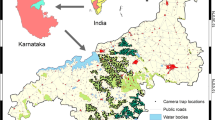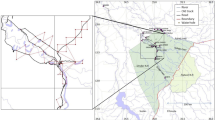Abstract
Wildlife reserves are becoming increasingly isolated from the surrounding human-dominated landscapes particularly in Asia. It is imperative to understand how species are distributed spatially and temporally in and outside reserves, and what factors influence their occurrence. This study surveyed 7500 km2 landscape surrounding five reserves in the Western Ghats to examine patterns of occurrence of five herbivores: elephant, gaur, sambar, chital, and pig. Species distributions are modeled spatio-temporally using an occupancy approach. Trained field teams conducted 3860 interview-based occupancy surveys in a 10-km buffer surrounding these five reserves in 2012. I found gaur and wild pig to be the least and most wide-ranging species, respectively. Elephant and chital exhibit seasonal differences in spatial distribution unlike the other three species. As predicted, distance to reserve, the reserve itself, and forest cover were associated with higher occupancy of all species, and higher densities of people negatively influenced occurrence of all species. Park management, species protection, and conflict mitigation efforts in this landscape need to incorporate temporal and spatial understanding of species distributions. All species are known crop raiders and conflict prone locations with resources (such as water and forage) have to be monitored and managed carefully. Wildlife reserves and adjacent areas are critical for long-term persistence and habitat use for all five herbivores and must be monitored to ensure wildlife can move freely. Such a large-scale approach to map and monitor species distributions can be adapted to other landscapes to identify and monitor critical habitats shared by people and wildlife.






Similar content being viewed by others
References
Athreya V, Odden M, Linnell JDC, Karanth KU (2010) Translocation as a tool for mitigating conflicts with leopards in human-dominated landscapes of India. Conserv Biol. doi:10.1111/j.1523-1739.2010.01599.x
Athreya V, Odden M, Linnell JDC, Krishnaswamy J, Karanth KU (2013) Big cats in our backyards: persistence of large carnivores in a human dominated landscape in India. PLoS One 8:e57872. doi:10.1371/journal.pone.0057872
Averbeck C, Apio A, Plath M, Wronski T (2009) Environmental parameters and anthropogenic effects predicting the spatial distribution of wild ungulates in the Akagera savannah ecosystem. Afr J Ecol 47:756–766
Beyer HL (2004) Hawth’s tools for ArcGIS
Brashares JS, Arcese P, Sam MK (2001) Human demography and reserve size predict wildlife extinction in West Africa. Proc R Soc B 268:2473–2478
Burnham KP, Anderson DR (2002) Model selection and multimodel inference: a practical information-theoretic approach. Springer, New York, pp 267–351
Caro TM, Pelkey N, Borner M, Campbell KL, Woodworth BL, Farm BP, Kuwai JO, Huish SA, Severre ELM (1998) Consequences of different forms of conservation for large mammals in Tanzania: preliminary analyses. Afr J Ecol 36:303–320
Carroll C, Noss RF, Paquet PC, Schumaker NH (2004) Extinction debt of protected areas in developing landscapes. Conserv Biol 18:1110–1120
Census of India (2011) Government of India. http://censusindia.gov.in/2011-prov-results/indiaatglance.html. Accessed 3 Jan 2012
Cleaveland S, Packer C, Hampson K, Kaare M, Kock R, Craft M, Limbo T, Mlengeya T, Dobson A (2008) The multiple roles of infectious diseases in the Serengeti ecosystem. In: Sinclair ARE, Packer C, Mduma SAR, Fryxell JM (eds) Serengeti III: human impacts on ecosystem dynamics. University of Chicago Press, Chicago, p 209–239
DeFries R, Hansen AJ, Turner BL, Reid R, Liu J (2007) Land use change around protected areas: management to balance human needs and ecological function. Ecol Appl 17:1031–1038
DeFries R, Karanth KK, Pareeth SJ (2010) Interactions between protected areas and their surroundings in human-dominated tropical landscapes. Biol Conserv 143:2870–2880
Gaston KJ, Borges PAV, He F, Gaspar C (2006) Abundance, spatial variance and occupancy. J Anim Ecol 75:646–656
Gaston KJ, Jackson SF, Cant L, Cruz G (2008) The ecological performance of protected areas. Annu Rev Ecol Evol Syst 39:93–113
Gopalaswamy AM, Kumar NS, Karanth KU, Macdonald DW (2012) Estimating tropical forest ungulate densities from sign surveys using abundance models of occupancy. Anim Conserv. doi:10.1111/j.1469-1795.2012.00565.x
Graham MD, Douglas-Hamilton I, Adams WM, Lee PC (2009) The movement of African elephants in a human-dominated land-use mosaic. Anim Conserv 5:445–455. doi:10.1111/j.1469-1795.2009.00272.x
Gu W (2004) Absent or undetected? Effects of non-detection of species occurrence on wildlife habitat models. Biol Conserv 116:195–203
Hansen AJ, DeFries R (2010) Ecological mechanisms linking protected areas to surrounding lands. Ecol Soc Am 17:974–988
Jenkins CN, Joppa L (2009) Expansion of the global terrestrial protected area system. Biol Conserv 142:2166–2174
Jimenez-Alfaro B, Draper D, Nogues-bravo D (2012) Modeling the potential area of occupancy at fine resolution may reduce uncertainty in species range estimates. Biol Conserv 147:190–196
Joppa LN, Loarie SR, Pimm SL (2008) On the protection of “protected areas”. PLoS One 105:6673–6678
Karanth KK, Nichols JD, Hines JE, Karanth KU, Christensen NL (2009) Patterns and determinants of mammal species occurrence in India. J Appl Ecol 46:1189–1200
Karanth KK, Nichols JD, Karanth KU, Hines JE, Christensen NL (2010) The shrinking ark: patterns of large mammal extinctions in India. Proc R Soc Lond B 277:1971–1979
Karanth KU, Gopalaswamy AM, Kumar NS, Vaidyanathan S, Nichols JD, MacKenzie DI (2011) Monitoring carnivore populations at the landscape scale: occupancy modeling of tigers from sign surveys. J Appl Ecol 48:1048–1056
Karanth KK, Gopalaswamy AM, DeFries R, Ballal N (2012) Assessing patterns of conflict loss and compensation distribution around a central Indian protected area. PLoS One. doi:10.1371/journal.pone.0050433
Karanth KK, Gopalaswamy AM, Prasad PK, Dasgupta S (2013a) Patterns of human-wildlife conflicts and compensation: insights from Western Ghats protected areas. Biol Conserv 166:175–185
Karanth KK, DeFries R, Naughton-Treves L, Gopalaswamy AM (2013b) Living with wildlife and mitigating human-wildlife conflicts around three Indian parks. Environ Manag 49:372–386. doi:10.1007/s00267-011-9778-1
Kumar A, Mudappa D, Raman TRS (2010) Asian elephant Elephas maximus habitat use and ranging in fragmented rainforest and plantations in the Anamalai Hills, India. Trop Conserv Sci 3:143–158
Livestock Census (2007) Department of Animal Husbandary, Dairying and Fisheries. Eighteenth Livestock Census. http://dahd.nic.in/Lstock.htm. Accessed 3 Jan 2012
MacKenzie DI, Nichols JD (2004) Occupancy as a surrogate for abundance estimation. Anim Biodivers Conserv 27:461–467
MacKenzie DI, Royle JA (2005) Designing occupancy studies: general advice and allocating survey effort. J Appl Ecol 42:1105–1114
MacKenzie DI, Nichols JD, Lachman GB, Droege S, Royle A, Langtimm CA (2002) Estimating site occupancy rates when detection probabilities are less than one. Ecology 83:2248–2255
Madhusudan MD, Karanth KU (2002) Local hunting and the conservation of large mammals in India. Ambio 31:49–54
Martin J, Chamaille-Jammes S, Nichols JD, Fritz H, Hines JE, Fonnesbeck CJ, MacKenzie DI, Bailey LL (2010) Simultaneous modeling of habitat suitability, occupancy, and relative abundance: African elephants in Zimbabwe. Ecol Appl 20:1173–1182
Naughton-Treves L, Mena JL, Treves A, Alvarez N, Radeloff VC (2003) Wildlife survival beyond park boundaries: the impact of slash-and-burn agriculture and hunting on mammals in Tambopata, Peru. Conserv Biol 17:1106–1117
O’Connell AF Jr, Talancy NW, Bailey LL, Sauer JR, Cook R, Gilbert AT (2006) Estimating site occupancy and detection probability parameters for meso- and large mammals in a coastal ecosystem. J Wild Manag 70:1625–1633
Packer C, Altizer S, Appel M, Brown E, Martenson J, O’Brien SJ, Roelke-Parker M, Hofmann-Lehmann R, Lutz H (1999) Viruses of the Serengeti: patterns of infection and mortality in African lions. J Anim Ecol 68:1161–1178
Pillay R, Johnsingh AJT, Raghunath R, Madhusudan MD (2011) Patterns of spatiotemporal change in large mammal distribution and abundance in the southern Western Ghats, India. Biol Conserv 144:1567–1576
Prugh LR, Hodges KE, Sinclair ARE, Brashares JS (2008) Effect of habitat area and isolation on fragmented animal populations. Proc Natl Acad Sci 105:20770–20775
Rannestad OT, Danielsen T, Moe SR, Stokke S (2006) Adjacent pastoral areas support higher densities of wild ungulates during the wet season than the lake Mburo national park in Uganda. J Trop Ecol 22:675–683
Royle JA, Nichols JD (2003) Estimating abundance from repeated presence-absence data or point counts. Ecology 84:777–790
Royle JA, Nichols JD, Kery M (2005) Modeling occurrence and abundance of species when detection is imperfect. Oikos 110:353–359
Sanderson EW, Jaiteh M, Levy MA, Redford KH, Wannebo AV, Woolmer G (2002) The human footprint and the last of the wild. Bioscience 52:891–904
Scholte P, Adam S, Serge BK (2007) Population trends of antelopes in Waza national park cameroon from 1960 to 2001: the interacting effects of rainfall, flooding and human interventions. Afr J Ecol 45:431–439
Setsaasa TH, Holmerna T, Mwakalebeb G, Stokke S, Roskaft E (2007) How does human exploitation affect impala populations in protected and partially protected areas?—a case study from the Serengeti ecosystem, Tanzania. Biol Conserv 136:563–570
Sinclair ARE, Mduma SAR, Hopcraft JGC, Fryxell JM, Hilborn R, Thirgood S (2007) Long-term ecosystem dynamics in the serengeti: lessons for conservation. Conserv Biol 21:580–590
Srinivasaiah NM, Anand VD, Vaidyanathan S, Sinha A (2012) Usual populations, unusual individuals: insights into the behavior and management of Asian elephants in fragmented landscapes. PLoS One 7(8):e42571. doi:10.1371/journal.pone.0042571
Stanley TR, Royle JA (2005) Estimating site occupancy and abundance using indirect detection indices. J Wild Manag 69:874–883
Thiollay J (2006) The decline of raptors in West Africa: long-term assessment and the role of protected areas. Ibis 148:240–254
Thirgood S, Anna M, Tham S, Hopcraft G, Mwangomo E, Mlengeya T, Kilewo M, Fryxell J, Sinclair ARE, Borner M (2004) Can parks protect migratory ungulates? The case of the Serengeti wildebeest. Anim Conserv 7:113–120
Western D, Russell S, Cuthill I (2009) The status of wildlife in protected areas compared to non-protected areas of Kenya. PLoS One 4:e6140. doi:10.1371/journal.pone.0006140
Willis KJ, Jeffers ES, Tovar C, Long PR, Caithness N, Smit MGD, Hagemann R, Collin-Hansen C, Weissenberger J (2012) Determining the ecological value of landscapes beyond protected areas. Biol Conserv 147:3–12
Woodroffe R (1998) Edge effects and the extinction of populations inside protected areas. Science 280:2126–2128
Acknowledgments
I am grateful to K. U. Karanth, P. M. Muthanna, D. V. Girish, B. M. Akarsha, S. Hulikere, N. S. Kumar, K. V. Phaniraj, C. U. Santhosh, N. Chapakanda, K. P. Vajepayam, R. Raghuram, Centre for Wildlife Studies and Wildlife Conservation Society-India program for advice and support. I thank the Karnataka Forest Department. I acknowledge the tireless field efforts of N. Ballal, P. Krishnaprasad, S. Dasgupta, A. Arunkumar, and assistance from V. Sankararaman and A. Srivathsa. I appreciate field efforts of the volunteers K. Abhirama, N. Aditya, M. Amarnath, Aparna, Aravind, A. Arun, S. Avinash, Beeresh, Krithika B. K, P. Bharadwaj, M. Bhogananjappa, V. Bode, C. Casiker, C. Ingaleshwar, Gagan, T. Ganesh, S. Girimaji, K. Hareesh, P. S. Harika, D. Hosur, P. Iyer, A. S. Jayalakshmi, T. R. Kumarswamy, M. Kale, K. Kotian, V. Krishnan, M. Kumaraswamy, A. Kumar, C. K. Kumar, H. Kumar, V. Kumar, A. Kulkarni, S. Kuduvalli, S. J. Karkala, P. Kumar, S. Koulagi, K. Poornima, N. J. Lazarus, Madhu, B. R. Madhukar, V. Mohithe, K. Mohan, P. Matada, P. Nag, V. Nagesh, P. Nadikerianda, V. Nataraja, A. Patavardhan, A. Pandey, V. Parameshwara, N. Prakash, V. Pawar, J. Pavan, M. Pasha, A. Prasad, S. Rao, Ramesh, R. S. Rahul, A. Srinivasa, A. Savalagi, A. Seetharam, I. Sreenath, T. Williams, T. Sridhara, R. Varsha for their support in the field. Grants from the National Geographic Society Conservation Trust, Rufford Small Grants and Ramanujan Fellowship supported the project.
Author information
Authors and Affiliations
Corresponding author
Electronic Supplementary Material
Below is the link to the electronic supplementary material.
Rights and permissions
About this article
Cite this article
Karanth, K.K. Wildlife in the Matrix: Spatio-Temporal Patterns of Herbivore Occurrence in Karnataka, India. Environmental Management 57, 189–206 (2016). https://doi.org/10.1007/s00267-015-0595-9
Received:
Accepted:
Published:
Issue Date:
DOI: https://doi.org/10.1007/s00267-015-0595-9




